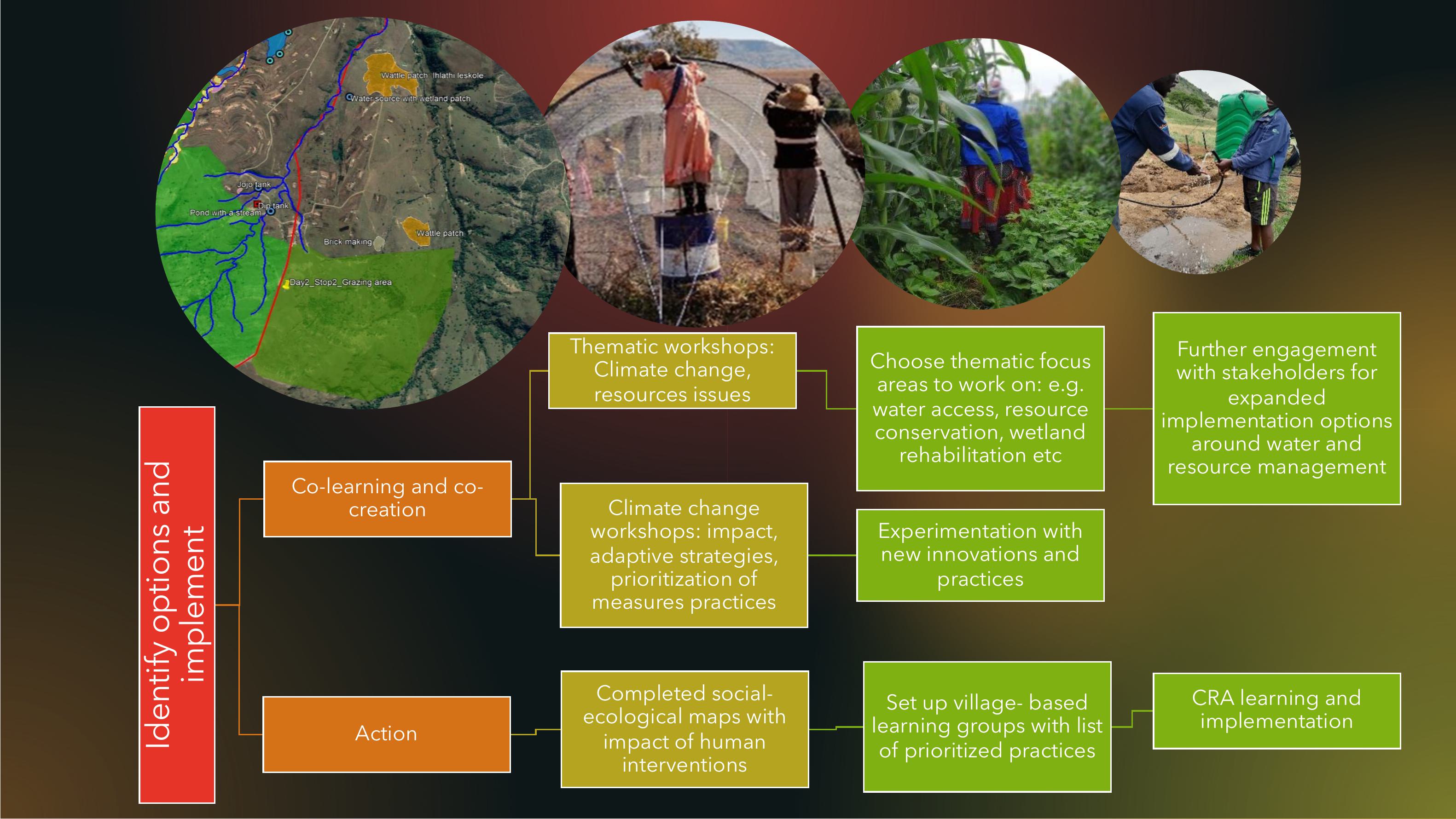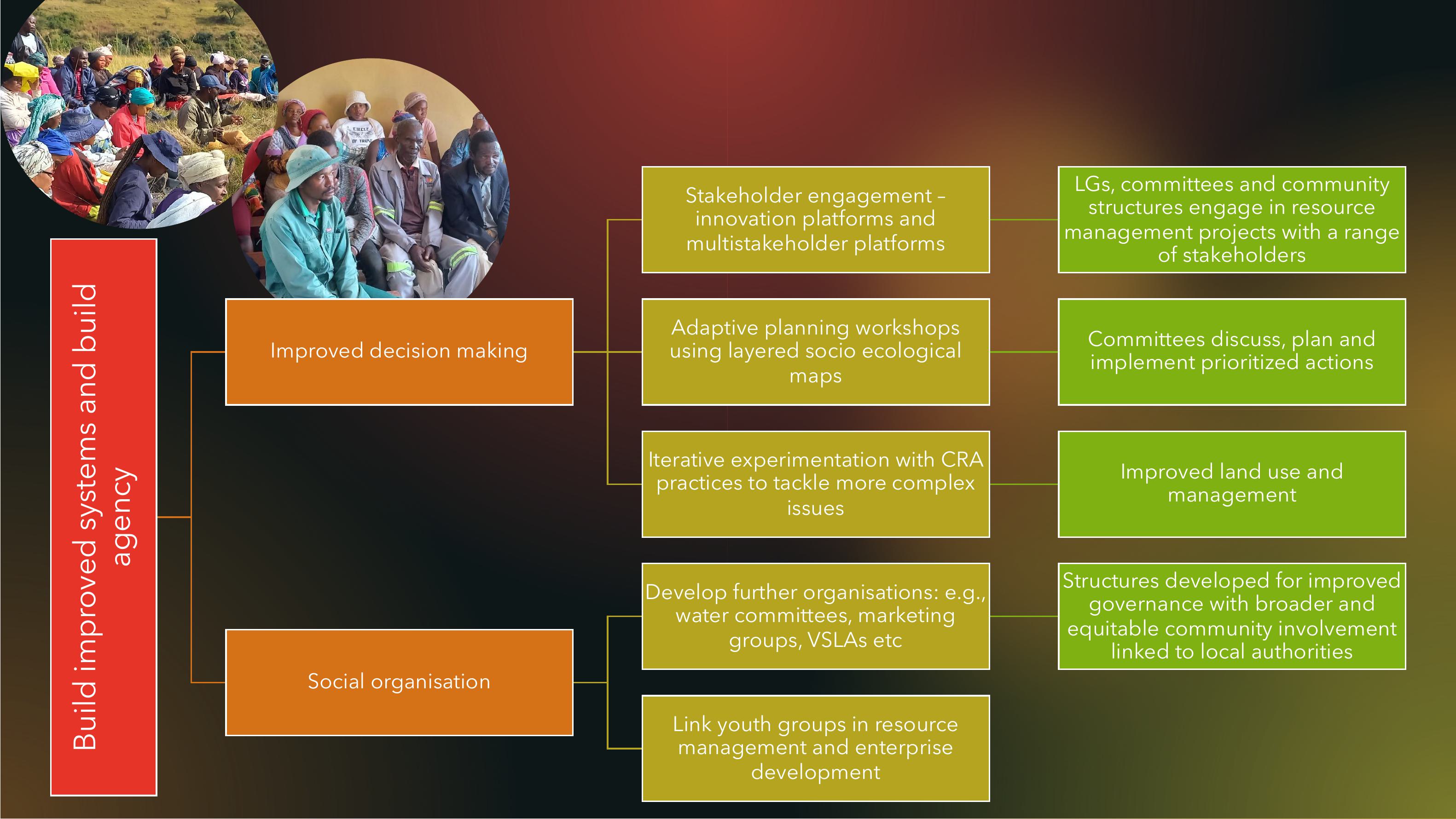
Frameworkforsocial-ecological community mapping and
planning

PRESENT SITUATION
INTERVENTIONS AND PROCESSES TO BUILD
SOCIAL AGENCY
IMPROVED DECISION MAKING AND
GOVERNANCE OUTCOMES
Actions
Joint analysis
(Outcomes) Actions/Outcomes
Co-learning
(Outcomes) Actions/Outcomes
Joint decision making
(Outcomes)
Focus group discussions and
mapping: socio
-
ecological patches
Present situation in land use and
management, including needs
and issues (emerging from
discussions)
Focus group discussions/ Thematic
workshop: CC, resource issues (erosion, alien
invasion, wetlands and rivers, water access,
grazing management)
Socio
-ecological mapping:
Impact of human interventions
and climate on the environment
Adaptive planning workshop using
layered socio ecological maps (expert
and community combined)
Management plan for water and land
resources
Village walks for detailed resource
discussions and mapping (key
informants)
Community workshops on CC impact
(social, economic, farming, resources).
Adaptive strategies (communities and
stakeholders combined)
CC impact and adaptive
strategies
Expert ecological mapping (GIS)
incl
EIA, Veld assessment, water
resource survey etc. (with key
informants)
Prioritization of adaptive measures, and
practices
Village based learning groups
Further social organisations develop
( including
markeintg
, microfinance,
water livestock etc.)
Linked youth groups in resource
management and enterprise
development
Experimentation with new practices and
innovations in Climate resilient agriculture
(Individual smallholders and support
organisations)
CRA experimentation and
implementation
Iterative experimentation with CRA
practices to tackle more complex
issues,
Improved land use and coordination
at community level
Seasonal review and re
-planning
Stakeholder engagement
-
innovation platforms and multi
stakeholder forums etc
Focus group discussions,individual
interviews
Local structures and decisions
made by them, including factors
that influence individual and
community decision making
(emerging from discussions)
Thematic focus areas: water access and
management , livestock and grazing
management, natural resources
management,
Marketing committees , VSLAs
Learning group discussions
and prioritization of urgent
issues
Committees discuss, plan and
implement (with support) prioritized
actions in thematic areas
Community level structures develop
for improved governance
- with
broader and equitable community
involvement linked to local and
traditional authorities
Further engagement with stakeholders for
expanded implementation options around
water and resource management
LGs, committees and community
structures engage in resource
management projects with a range
of stakeholders
OUTCOMES
Improved participatory decision
making to support implementation and
innovation
Improved governance
- new
community based structures
Improved governance improved rules
and logistics within community based
structures .
Improved governance
- coherent
collaboration with stakeholders and
role players.
Collect and
analyse
information
Identify
options and
implement
Build
improved
systems and
social agency

Presentsituation
Collect andanalyse
information
Focusgroupdiscussions
Land use and management
Social organisation
Mapping: social-ecological
patches
Individual interviews
Expert ecological mapping
(GIS)
EIA and veld assessment
Waterresourcesand
sources
Villagewalksfor detailed
resourcediscussions and
mapping (keyinformants)
Joint analysis
Presentsituationinlanduse
and management,
including needs and issues
Localstructures and
decision making:
Communityandindividual

Identify options and
implement
Co-learning and co-
creation
Thematic workshops:
Climate change,
resources issues
Choose thematic focus
areas to work on: e.g.
water access, resource
conservation, wetland
rehabilitationetc
Furtherengagement
with stakeholders for
expanded
implementation options
around water and
resource management
Climate change
workshops: impact,
adaptive strategies,
prioritization of
measures practices
Experimentation with
new innovations and
practices
Action
Completed social-
ecological maps with
impact of human
interventions
Set up village- based
learning groups with list
of prioritized practices
CRA learning and
implementation

Build improved systems and build
agency
Improved decision making
Stakeholder engagement –
innovation platforms and
multistakeholder platforms
LGs, committeesandcommunity
structures engage in resource
management projects with a range
of stakeholders
Adaptive planning workshops
using layered socio ecological
maps
Committees discuss,plan and
implement prioritized actions
Iterative experimentation with CRA
practices to tackle more complex
issues
Improved land use and
management
Social organisation
Develop further organisations: e.g.,
water committees, marketing
groups,VSLAs etc
Structures developed for improved
governance with broader and
equitable community involvement
linked to local authorities
Link youth groups in resource
management and enterprise
development

Presentsituation
Identify options and implement
Build improvedsystems and build
agency
Innovation •Improved participatory decision
making and implementation
Governance
•New community-based structures
•Improved rules and logistics within
existing and new community-based
structures
Linkages •Coherent collaboration with
stakeholders and role players